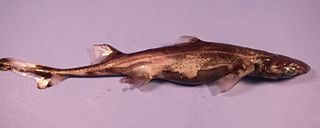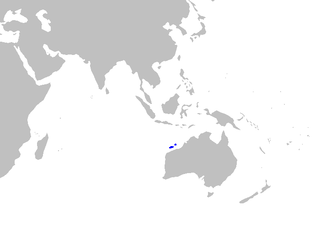
The blackbelly lanternshark or lucifer shark is a shark of the family Etmopteridae found around the world in tropical and temperate seas at depths between 150 and 1,250 meters – the mesopelagic zone. Compared to other mesopelagic fish predators and invertebrates, the blackbelly lanternshark is thought to reside in shallower, more southern waters. E. lucifer can reach up to 47 centimeters in length and consumes mesopelagic cephalopods, fish, and crustaceans. Blackbelly lanternsharks are bioluminescent, using hormone controlled mechanisms to emit light through ventral photogenic organs called photophores and are presumed to be ovoviviparous. The blackbelly lanternshark has been classified as "Not Threatened" within the New Zealand Threat Classification System.

Etmopterus is a genus of lantern sharks in the squaliform family Etmopteridae. They are found in deep sea ecosystems of the Atlantic, Indian and Pacific Oceans.

The blurred lanternshark is a little-known species of dogfish shark in the family Etmopteridae, found around the world in benthic and pelagic habitats from a depth of 110 m (360 ft) to over 1 km (0.62 mi) down. This shark forms the E. pusillus species group with the smooth lanternshark, which are distinguished from other members of its family by having irregularly arranged, flat-topped dermal denticles that give them a "smooth" appearance. Both species are slender-bodied with long heads, two dorsal fins bearing spines, no anal fins, and light-emitting photophores. The blurred lanternshark is larger, reaching 67 cm (26 in) or more in length. This species feeds on small squid, fishes, and fish eggs, and is ovoviviparous. It has been assessed as of Least Concern by the International Union for Conservation of Nature, because of its wide distribution and lack of threat from fishing pressure.

The smooth lanternshark or slender lanternshark is a species of dogfish shark in the family Etmopteridae, found widely in the Atlantic and Pacific Oceans. It inhabits benthic environments at a depth of 274–1,000 m (899–3,281 ft), and pelagic environments at a depth of 0–708 m (0–2,323 ft). The smooth lanternshark forms a species group with the larger blurred lanternshark, both of which are distinguished from other members of their family by small, irregularly arranged dermal denticles with a truncated shape. This species has a slender, dark brown body with an indistinct black band on the sides over the pelvic fins, and reaches 50 cm (20 in) in length. This slow-growing, ovoviviparous shark feeds on smaller squid, fishes, and fish eggs. Smooth lanternsharks are often caught as bycatch in eastern Atlantic and Japanese commercial fisheries. The International Union for Conservation of Nature (IUCN) has evaluated this species as of Least Concern because of its wide distribution and limited threats.

The velvet belly lanternshark is a species of dogfish shark in the family Etmopteridae. One of the most common deepwater sharks in the northeastern Atlantic Ocean, the velvet belly is found from Iceland and Norway to Gabon and South Africa at a depth of 20–2,490 m (66–8,169 ft). A small shark generally no more than 45 cm (18 in) long, the velvet belly is so named because its black underside is abruptly distinct from the brown coloration on the rest of its body. The body of this species is fairly stout, with a moderately long snout and tail, and very small gill slits. Like other lanternsharks, the velvet belly is bioluminescent, with light-emitting photophores forming a species-specific pattern over its flanks and abdomen. The ventral photophores are thought to function in counter-illumination, which camouflages the shark against predators and prey. The bioluminescent flank markings may play a role in intraspecific communication.

The short-tail lanternshark is a shark of the family Etmopteridae found in the western Pacific between latitudes 37°N and 30°S, at depths of between 450 and 900 m. Its length is up to 50 cm (20 in).

The cylindrical lanternshark or Carter Gilbert's lanternshark is a shark of the family Etmopteridae found along the Caribbean coast of Colombia in South America, at depths of between 285 and 355 m. Its maximum length is 21 cm.

The combtoothed lanternshark is a shark of the family Etmopteridae the only specimen, and holotype, being found from the South China Sea between the Viet Nam coast and Hainan Island, at a depth of between 510 and 690 m. The holotype's length is 29 cm.

The Hawaiian Lanternshark is a species of small squaliform shark in the family Etmopteridae.

The fringefin lanternshark is a shark of the family Etmopteridae found in the western central Atlantic from Texas to Florida, northern Gulf of Mexico, and Mexico. It is endemic to this area. It is a deep water shark and is found about 220 to 915 meters below the surface, on the upper continental slopes of the Gulf. E. schultzi is a small shark, about 27–30 cm long and feeds on squid. It is also bioluminescent, which counter-illuminates it and helps with intraspecific interaction. Due to its limited range and the difficulty of collecting deep water species, it has not been evaluated by the IUCN Red List, but due to recent oil spills in the Gulf of Mexico, it is likely that fringefin lanternsharks have decreased in population.

The smalleye lanternshark is a shark of the family Etmopteridae found in the southeast Pacific off Peru and Chile, at depths between 630 and 1,100 m. Its length is up to 61 cm (24 in).

The great lanternshark is a shark of the family Etmopteridae found in the northeast and northwest Atlantic. Its name was given because, at the time of its discovery, it was thought to be bioluminescent, but this has been challenged.

The splendid lanternshark is a shark of the family Etmopteridae found in the western Pacific at depths between 120 and 210 m. Through the classification of Etmopterus species into several clades based on the positioning of their bioluminescent photophores, the splendid lanternshark can be considered a member of the Etmopterus pusillus clade.

The brown lanternshark or bristled lanternshark is a little-known species of deep-sea dogfish shark in the family Etmopteridae. It is found off Japan and New Zealand, and possibly also South Africa and Australia, typically deeper than 300 m (980 ft). This species can be distinguished from other lanternsharks by its coloration, which is a uniform dark gray or brown without the ventral surface being much darker and clearly delineated from the rest of the body. The brown lanternshark feeds on small bony fishes, cephalopods, and crustaceans. Reproduction is ovoviviparous, with females giving birth to 9–18 young. An unusually high proportion of individuals in Suruga Bay are hermaphrodites, with both male and female characteristics.

The blackmouth lanternshark is a species of dogfish shark within the family Etmopteridae. This species is part of a subgroup that includes one other species from within the family. It is known to inhabit the benthic zones of the Eastern Indian Ocean and the Arafura Sea. These sharks were first described in a 2002 issue of Cybium, and there is still much unknown about the species.

The pygmy lanternshark is a shark of the family Etmopteridae found in the eastern Indian Ocean from northern Western Australia and possibly Java, at depths of between 430 and 550 m. Its length is up to 26 cm.

Etmopterus burgessi, sometimes known as the broad-snout lanternshark, is a lanternshark of the family Etmopteridae in the order Squaliformes. It is found only around Taiwan.

The shortfin smooth lanternshark is a shark of the family Etmopteridae found off the northeastern coast of Taiwan, at depths of between 430 and 550 m.

The blue-eye lanternshark, also known as the traveller lanternshark or slate lanternshark is a shark of the family Etmopteridae.

Etmopterus compagnoi is a shark of the family Etmopteridae found in the southeast Atlantic off southwestern Cape Province and northern Natal in South Africa at a depth of 479 to 923 metres. It is sometimes considered conspecific with the brown lanternshark.





















